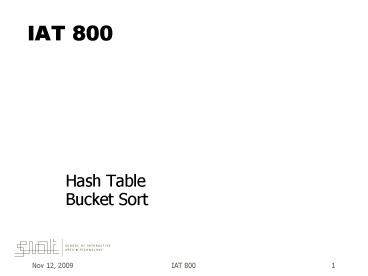Hash Table - PowerPoint PPT Presentation
Title:
Hash Table
Description:
An array in which items are not stored consecutively - their place of storage is ... Hashed key: the result of applying ... Each table position is a linked list ... – PowerPoint PPT presentation
Number of Views:112
Avg rating:3.0/5.0
Title: Hash Table
1
IAT 800
- Hash Table
- Bucket Sort
2
Hash Table
- An array in which items are not stored
consecutively - their place of storage is
calculated using the key and a hash function - Hashed key the result of applying a hash
function to a key - Keys and entries are scattered throughout the
array
key
entry
4
hash function
array index
Key
10
123
3
Hashing
- insert calculate place of storage, insert
TableNode O(1) - find calculate place of storage, retrieve entry
O(1) - remove calculate place of storage, set it to
null O(1)
key
entry
4
10
123
4
Hashing example
- 10 stock details, 10 table positions
key
entry
- Stock numbers between 0 and 1000
85 85, apples
0
- Use hash function stock no. / 100
- What if we now insert stock no. 350?
- Position 3 is occupied there is a collision
323 323, guava
462 462, pears
- Collision resolution strategy insert in the next
free position (linear probing)
350 350, oranges
- Given a stock number, we find stock by using the
hash function again, and use the collision
resolution strategy if necessary
912 912, papaya
5
Hashing performance
- The hash function
- Ideally, it should distribute keys and entries
evenly throughout the table - It should minimize collisions, where the position
given by the hash function is already occupied - The collision resolution strategy
- Separate chaining chain together several
keys/entries in each position - Open addressing store the key/entry in a
different position - The size of the table
- Too big will waste memory too small will
increase collisions and may eventually force
rehashing (copying into a larger table) - Should be appropriate for the hash function used
and a prime number is best
6
Hash function
- Truncation
- Ignore part of the key and use the rest as the
array index (converting non-numeric parts) - A fast technique, but check for an even
distribution throughout the table - Folding
- Partition the key into several parts and then
combine them in any convenient way - Unlike truncation, uses information from the
whole key - Modular arithmetic (used by truncation folding,
and on its own) - To keep the calculated table position within the
table, divide the position by the size of the
table, and take the remainder as the new position
7
Hash Function Examples
- Truncation If students have an 9-digit
identification number, take the last 3 digits as
the table position - e.g. 925371622 becomes 622
- Folding Split a 9-digit number into three
3-digit numbers, and add them - e.g. 925371622 becomes 925 376 622 1923
- Modular arithmetic If the table size is 1000,
the first example always keeps within the table
range, but the second example does not (it should
be mod 1000) - e.g. 1923 mod 1000 923 (in Java 1923
1000)
8
Choosing the table size to minimize collisions
- As the number of elements in the table increases,
the likelihood of a collision increases - so make
the table as large as practical - If the table size is 100, and all the hashed keys
are divisible by 10, there will be many
collisions! - Particularly bad if table size is a power of a
small integer such as 2 or 10 - More generally, collisions may be more frequent
if - greatest common divisor (hashed keys, table size)
gt 1 - Therefore, make the table size a prime number
(gcd 1)
Collisions may still happen, so we need a
collision resolution strategy
9
Collision resolution chaining
- Each table position is a linked list
- Add the keys and entries anywhere in the list
(front easiest) - Advantages over open addressing
- Simpler insertion and removal
- Array size is not a limitation (but should still
minimize collisions make table size roughly
equal to expected number of keys and entries) - Disadvantage
- Memory overhead is large if entries are small
No need to change position!
4
10
123
10
Applications of Hashing
- Compilers use hash tables to keep track of
declared variables - A hash table can be used for on-line spelling
checkers if misspelling detection (rather than
correction) is important, an entire dictionary
can be hashed and words checked in constant time - Hash functions can be used to quickly check for
inequality if two elements hash to different
values they must be different - Storing sparse data
11
When not to use hashing?
- Hash tables are very good if there is a need for
many searches in a reasonably stable table - Hash tables are not so good if there are many
insertions and deletions, or if table traversals
are needed - If there are more data than available memory then
use a tree - Also, hashing is very slow for any operations
which require the entries to be sorted - e.g. Find the minimum key
12
Bucket Sort
- For Each item to be sorted, compute
- entryIndex key / tableSize
- Chain entries on collision
- Result Each table entry has all the entries in a
range of key values - For some problems, this is enough
- Collision Detection
4
10
123































